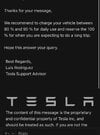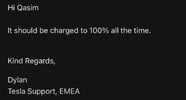I’m very confused on how to charge my lfp battery, the recommendation under the charging section says to charge once weekly to 100 and to keep the charge limit to 100, I’ve read a lot of posts and everyone does different things… I decided to query it with Tesla and informed them I have a model y with an lfp battery, I use 20% to commute to work and back home, is it safe to charge from 80-100 daily for this and got the following reply. This has confused me because they haven’t even said to charge it once a week to 100. I’ve decided to query again to see what they say  any help will be appreciated
any help will be appreciated
Welcome to Tesla Motors Club
Discuss Tesla's Model S, Model 3, Model X, Model Y, Cybertruck, Roadster and More.
Register
Install the app
How to install the app on iOS
You can install our site as a web app on your iOS device by utilizing the Add to Home Screen feature in Safari. Please see this thread for more details on this.
Note: This feature may not be available in some browsers.
-
Want to remove ads? Register an account and login to see fewer ads, and become a Supporting Member to remove almost all ads.
You are using an out of date browser. It may not display this or other websites correctly.
You should upgrade or use an alternative browser.
You should upgrade or use an alternative browser.
Model y lfp battery charging habits
- Thread starter qasimjh
- Start date
The reason to charge an LFP battery to 100% once a week is to allow the Battery Management System to recalibrate. LFP batteries have a more non-linear voltage vs charge curve so harder to determine the battery capacity compared to Nickel li-ion. At the same time, LFP batteries have less degradation being at 100% than Nickel Li-ion so ok to do it. Note that it’s still better for LFP to be at less than 100% for long periods so that’s why just once a week.
Tam
Well-Known Member
I’m very confused on how to charge my lfp battery, the recommendation under the charging section says to charge once weekly to 100 and to keep the charge limit to 100, I’ve read a lot of posts and everyone does different things… I decided to query it with Tesla and informed them I have a model y with an lfp battery, I use 20% to commute to work and back home, is it safe to charge from 80-100 daily for this and got the following reply. This has confused me because they haven’t even said to charge it once a week to 100. I’ve decided to query again to see what they sayany help will be appreciated
Tesla gave you the charging limit instructions on the conventional Lithium battery and not LFP.
How do you know your car is LFP?
If you have LFP, and not charging 100% at least weekly, your car would give you an onscreen reminder to do it.
The rational for that LFP instructions is better accuracy of your battery gauge. Some didn't keep that practice and ran out of battery even when the gauge shows that there are still lots of miles and percentages left.
I checked under vehicle information and thanksTesla gave you the charging limit instructions on the conventional Lithium battery and not LFP.
How do you know your car is LFP?
If you have LFP, and not charging 100% at least weekly, your car would give you an onscreen reminder to do it.
The rational for that LFP instructions is better accuracy of your battery gauge. Some didn't keep that practice and ran out of battery even when the gauge shows that there are still lots of miles and percentages left.
GtiMart
Active Member
As Bruce said, 100% is for the BMS to stay calibrated. Initially some people were left stranded with a car that suddenly went from say 7% to 0%/"stop now" because the BMS wasn't calibrated.
That doesn't mean the car needs to idle at 100% all the time. You need to reach 100% "at least once a week" as Tesla says for the BMS to be precise, but it won't matter if you never go below say 20%. The LFP battery will still degrade less if you charge lower as other batteries, but the difference is less important. For many people the LFP degrades so little that's it's just not worth the hassle to manage the charge. It surely is simpler to just plug all the time and leave the slider to 100%, waking up to a "full tank" every morning. I have a friend that would not have bough another Tesla model because he didn't want that hassle.
Whether the couple percent degradation after a few years is worth the trouble or not is up to you. Just know that it's less than other battery types.
That doesn't mean the car needs to idle at 100% all the time. You need to reach 100% "at least once a week" as Tesla says for the BMS to be precise, but it won't matter if you never go below say 20%. The LFP battery will still degrade less if you charge lower as other batteries, but the difference is less important. For many people the LFP degrades so little that's it's just not worth the hassle to manage the charge. It surely is simpler to just plug all the time and leave the slider to 100%, waking up to a "full tank" every morning. I have a friend that would not have bough another Tesla model because he didn't want that hassle.
Whether the couple percent degradation after a few years is worth the trouble or not is up to you. Just know that it's less than other battery types.
Th
Thank you for your replyAs Bruce said, 100% is for the BMS to stay calibrated. Initially some people were left stranded with a car that suddenly went from say 7% to 0%/"stop now" because the BMS wasn't calibrated.
That doesn't mean the car needs to idle at 100% all the time. You need to reach 100% "at least once a week" as Tesla says for the BMS to be precise, but it won't matter if you never go below say 20%. The LFP battery will still degrade less if you charge lower as other batteries, but the difference is less important. For many people the LFP degrades so little that's it's just not worth the hassle to manage the charge. It surely is simpler to just plug all the time and leave the slider to 100%, waking up to a "full tank" every morning. I have a friend that would not have bough another Tesla model because he didn't want that hassle.
Whether the couple percent degradation after a few years is worth the trouble or not is up to you. Just know that it's less than other battery types.
Your Luis Rodriguez and “Dylan” probably never read your original question, or had a clue on which Tesla you own. Humans. By definition 50% of humans are below average IQ, and more often than not, lazy, not good in the their jobs
gforce2002
Member
It should be fine. Thats what I do, top it up if necessary for upcoming drives, but if I’m only driving local I’ll let it go a few days so it’s not sitting at 100 all the time. Charging to 100 doesn’t hurt so much as letting it sit at 100 for long periods.So just to clarify if I were to top it up to 100% a few times a week would still be ok??
Ok thankyou that’s good to know.It should be fine. Thats what I do, top it up if necessary for upcoming drives, but if I’m only driving local I’ll let it go a few days so it’s not sitting at 100 all the time. Charging to 100 doesn’t hurt so much as letting it sit at 100 for long periods.
Also I’ve noticed when I get in my car straight after charging for the night that the cabin temp is pretty warm and even the air coming from the air con is warm for a few minutes.
Where as turning the air con on when I haven’t been charging is quite instant. Is it normal to have that heat/warmth generated? I know the charging works best in the warmer batteries but just wanted to make sure that’s the way it’s meant to be
gforce2002
Member
That's likely going to depend on the ambient temperature around the car and whether the battery needed heating as it charged, which I suppose would leave the coolant in a warmed state. I wouldn't think it would have a big effect to the vent temperature though. As long as the HVAC is cooling/heating the cabin normally, I don't think I'd worry.
Yeah after a minute or two the cool air comes flowing as normal ..That's likely going to depend on the ambient temperature around the car and whether the battery needed heating as it charged, which I suppose would leave the coolant in a warmed state. I wouldn't think it would have a big effect to the vent temperature though. As long as the HVAC is cooling/heating the cabin normally, I don't think I'd worry.
gforce2002
Member
Similar threads
- Replies
- 74
- Views
- 4K
- Replies
- 4
- Views
- 607
- Replies
- 2
- Views
- 861




